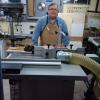I'm looking for recommendations based on your experiences even though the title of this posting seems like it's already answered the question--what's the best blade to use for ripping 45-degree miter cuts. Would the cuts be cleaner and easier to make with a dedicated rip blade, or could a decent combination blade do the job just as well if not better. As a point of reference, I'm going to be cutting these miters on both sides of 3/4" red oak boards (finished dimension), at 3-1/2" in width with varying lengths of 22" to 64". The work will be done on a 2-hp, 10" table saw.
I have a dedicated Oshlun SBW-100024 rip blade (24 tpi, ATB, .126" kerf) that does a decent job with 90-degree rips and a Forrest WWII (40 tpi, ATB, .125" kerf) that's typically been my go-to for different types of cuts like miters and coves. But would either of these be better suited to making the long miter rips at 45-degrees?





 Reply With Quote
Reply With Quote





